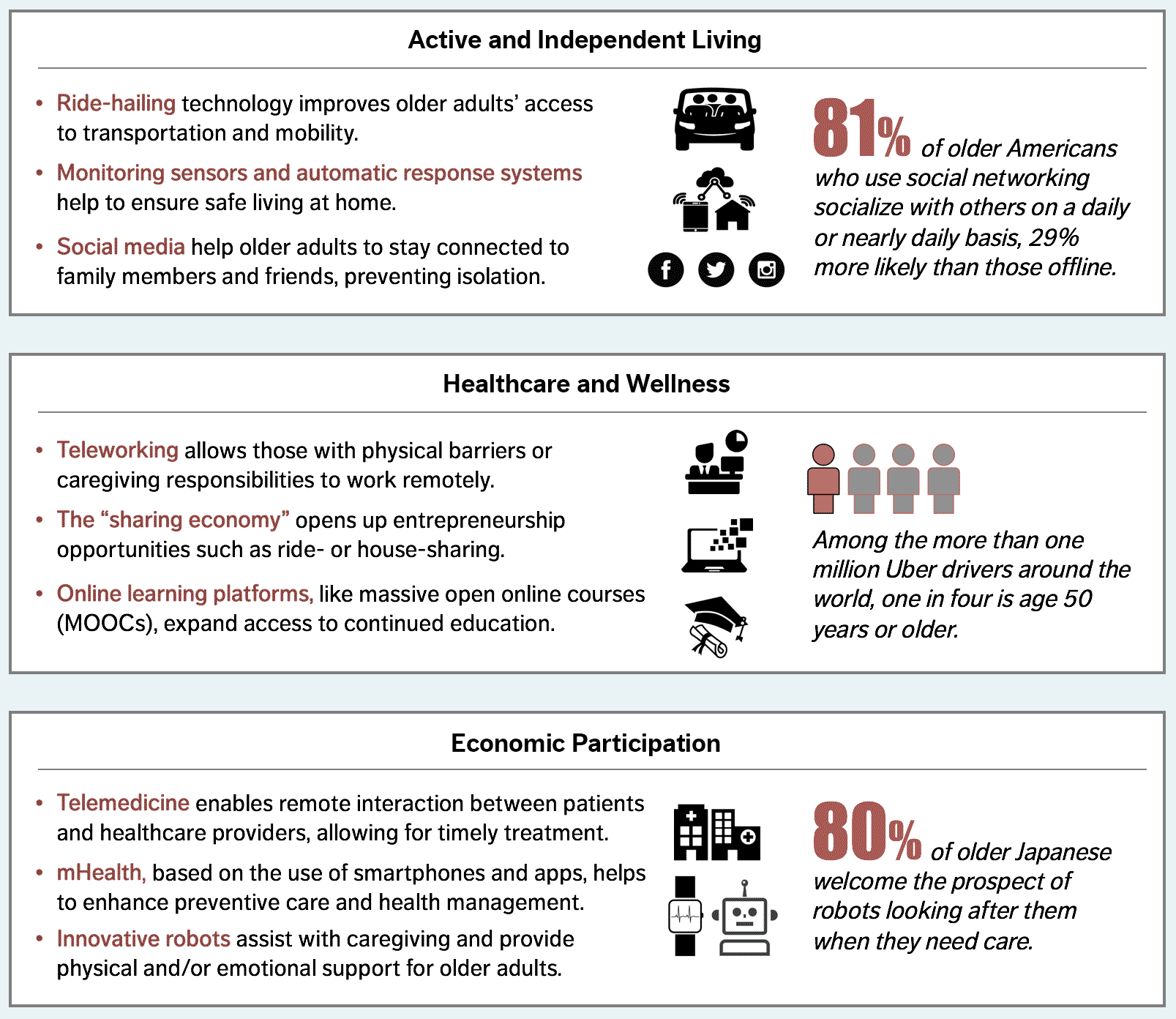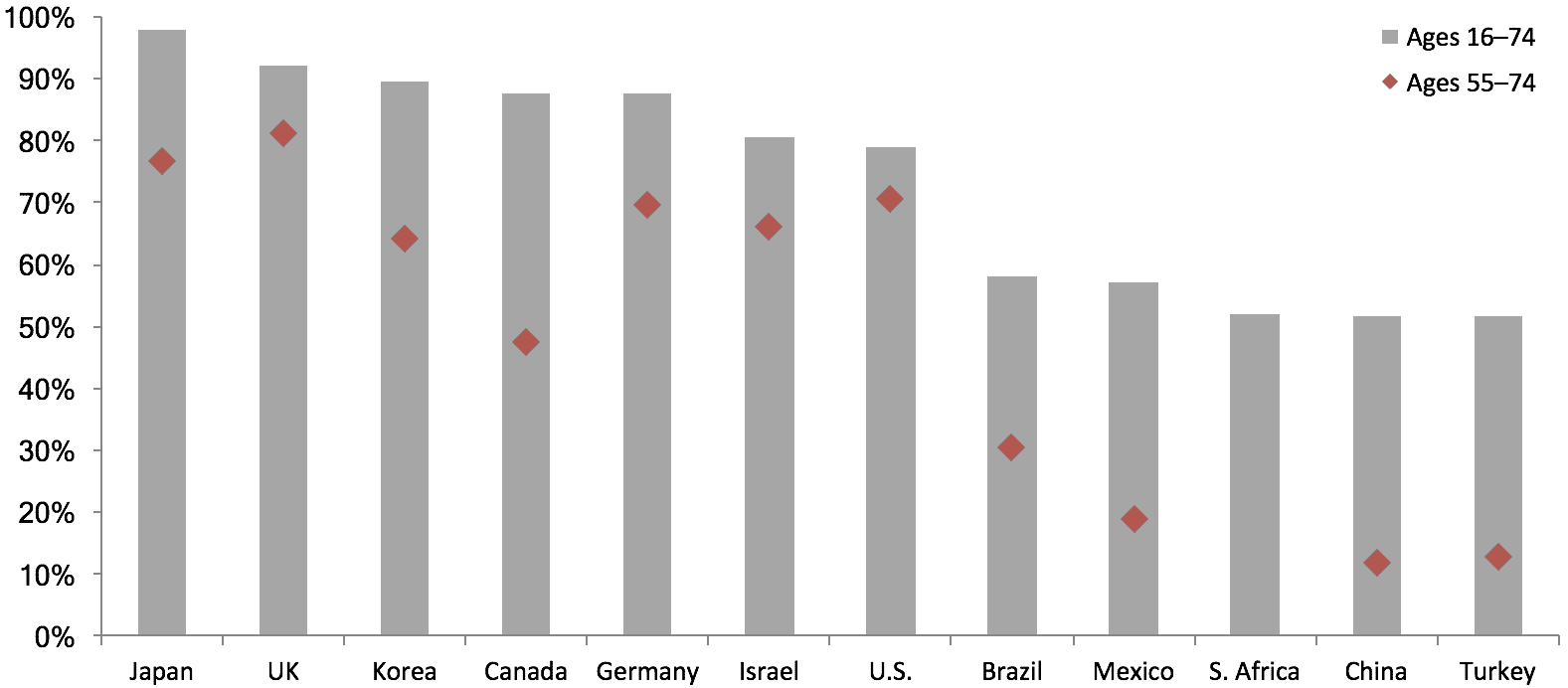Globally, the aging trend is converging with a wave of technological advancements that could transform the economic and social engagement and health of older people – reducing costs, increasing access, and creating a unique opportunity to turn aging into a pathway for growth. However, the digital transformation has yet to live up to its potential. While older adults are among those who could benefit most from technological advancements, they have lagged on the adoption of technology. Still relatively small-scale in most countries, efforts are beginning to close the gap by helping older adults realize the value of technology and promote digital literacy, as well as developing technology-driven products and services for this market, including from the private sector, which has been driving much of its growth.
Digital technology can influence every aspect of older people’s lives

(Sources: OECD; Pew Research; Neumann, D.; FP Analytics)
Digital Inclusion
Realizing the potential of digital transformation will require breaking through the digital divide. Older adults are eager adopters of technologies that offer clear benefits, as demonstrated by the relative popularity of various social media tools. However, they are often unaware of these benefits or lack the skills and confidence to access them. Relatively small-scale projects around the world are experimenting with ways to best overcome these obstacles, including initiatives that demonstrate the usefulness of technology with direct application to older adults’ lives and provide tailored, peer-to-peer training.
Since 2011, over 90 percent of OECD countries with data available have seen the growth in online social networking usage outstrip that in internet usage among the population age 55 through 74. In the U.S., which has the smallest digital divide among the ARC countries, older adults who obtain news on social media engage with news on these platforms at similar rates as those of ages 18 through 29.
Internet Users as a Percentage of Population, by Age Group (2015 or nearest)

Senior Planet Exploration Center in the U.S.
Older Adult Technology Services (OATS), a U.S. social-impact organization, launched the Senior Planet Exploration Center in 2013 to use digital technology to help older adults stay connected, work, and live independently in the digital era. The Center is centrally located in Manhattan and outfitted with state-of-the-art digital technology. It not only provides training courses on how to use the internet and devices like PCs and iPads, as traditional training centers do, but also shows older people how to use technology for social engagement. One interesting initiative is “Team Senior Planet,” where older adults learn exercise techniques with the assistance of devices such as Fitbit. Through another initiative called “Money Matters,” older adults are shown how to do online price comparisons and use resources like e-commerce to save money or earn extra income. The Center has also hosted various events to inspire creativity among older people, such as developing digital art. The Center, together with its 23 satellite technology labs, serves around 20,000 older residents in New York City each year. Building on this success, in 2015 OATS opened a second Senior Planet Exploration Center in Plattsburgh, a town in upstate New York, and is also working with the government of Israel to develop a model that is tailored to the needs of older adults in that country.
Private-Sector Engagement
The private sector is beginning to recognize the tremendous potential of digital products to meet the needs of older consumers, although this has been limited to markets with high-income consumers. In spite of this growing enthusiasm, furthering private-sector engagement in this market faces three barriers. Risk aversion prevents companies from making bold moves and rapidly responding to this still nascent market opportunity. For those that are eager to enter the market, funding and commercialization challenges, as well as a lack of familiarity of the older consumer segment, are the main obstacles to the development and marketing of technologies that suit older adults’ needs and interests. Early efforts have been made by both the public and private sector to prompt companies to participate in building the aging-related technology market by helping address these challenges.
Globally, the number of older adults is growing faster than the populations of any other age group, and their spending power is projected to total USD 15 trillion by 2020. Among the ARC countries, people age 65 or older in all industrialized economies (except Korea), as well as China and Brazil, are on average spending more than those ages 25 through 64.
Over the period from 2010 through 2015, more than half of VC, PE, and corporate funds invested into health-related technology and 47 percent of the investment deals were focused on products and services that could be used by those age 50 or older. The annual funds invested to target this 50-and-older segment rose five-fold, and the annual deal number tripled.
China’s Policy Push to Develop an Aging-Related Technology Market
Among emerging market economies, China stands out for its success in expanding its aging-related technology market, thanks to a strong policy push in recent years. Since 2013, the central government has introduced a rash of major policies to support aging in place and cultivate older-age care industries. With a focus on leveraging digital technology to develop innovative products and services, the government offers a range of incentives ranging from subsidies to preferential taxes. The government further incorporated the development of the smart older-age care sector into the national digital strategy – “Internet+” Action Plan – launched in July 2015. According to VCBeat Research, as of early 2016, 75 percent of startups in China that specialize in providing ICT-enabled products and services to older adults were established from 2013 through 2015. These companies cover an extensive range of products and services: 21 percent provide smart home-based or institution-based care systems, 18 percent provide older-age care services, and the rest focus on hardware, software, and e-business services, among others.
Key Takeaways
Digital technologies not only have the promise to improve the lives of older adults around the world – facilitating social and productive engagement and delivering improved health outcomes – but also significant economic gains, both in more efficient and lower-cost services, and opening up new market opportunities. However, significant gaps exist between the benefits technology can deliver and the extent to which older adults realize and use them, and between the products and services older adults demand and what the private sector actually provides. Governments, businesses, and other stakeholders can all play important roles in bridging these gaps, by:
- Eliminating digital exclusion by raising older adults’ awareness of the usefulness of technology and providing tailored training opportunities;
- Facilitating companies’ entry into this market through a strong policy push and funding and commercialization support; and
- Connecting innovators, product developers, and service providers with older consumes to enhance their understanding of the group and ability to serve its needs.